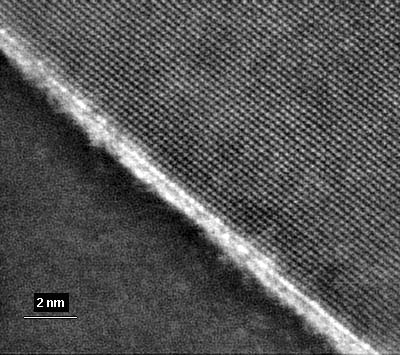Understanding toughness in brittle materials:
atomic-resolution studies of fracture in SiC
Advanced structural ceramics offer important advantages over current materials
used in high-temperature environments, such as increased thermal stability,
oxidation resistance, and high strength. However, the inherently brittle nature
of ceramics limits the use of materials like SiC and Si3N4 in applications such
as ultra-high temperature turbine engines. Understanding the mechanisms that
control fracture of brittle materials, at the atomic level, is the key to producing
high-toughness ceramics and unlocking the potential of these materials.
We use some of the most advanced microscopes in the world, including the new
TEAM microscope that can achieve 0.5 ? resolution, to study fracture in SiC.
We have learned that the controlling factors for producing crack deflection,
which leads to high toughness, include the stiffness of the grain boundary phase
(present in liquid-phase sintered products) and the toughness of the interface
between the grain boundary and the matrix grains. Both of these can be altered
by the choice of dopants used during sintering. By tailoring the fracture properties
of SiC, starting from the atomic level, we are working towards the goal of improving
the fracture toughness and reliability of brittle materials.

Figure 1: Raw Z-contrast STEM image of a grain boundary
in SiC with Yb additives. Bright contrast indicates the presence of
Yb. This material has a stiff grain boundary phase and a strong interface,
which leads to transgranular fracture and poor toughness.
|
Additional publications on SiC:
- In
situ measurement of fatigue crack growth rates in a silicon carbide
ceramic at elevated temperatures using a DC potential system by D.
Chen, C.J. Gilbert, and R.O. Ritchie. American Society for Testing and
Materials, 2000
- Effects
of grain-boundary structure on the strength, toughness, and cyclic
fatigue
properties of a monolithic silicon carbide by D. Chen, X.F. Zhang,
and R.O. Ritchie. Journal of the American Ceramic Society, 2000
- Cyclic
Fatigue-Crack Growth and Fracture Properties in Ti3SiC2Ceramics
at Elevated Temperatures by D. Chen, K. Shirato, M. W. Barsoum, T.
El-Raghy, and R. O. Ritchie, Journal of the American Ceramic Society,
vol.84
(12), Dec. 2001, pp. 2914-2920
- Abrasive
Wear Behavior of Heat-Treated ABC-Silicon Carbide by X. F. Zhang,
G. Y. Lee, Da Chen, R. O. Ritchie, and L. C. De Jonghe, Journal of the
American Ceramic Society, vol 86 (8), 2003, pp. 1370-1378
LBNL ,
MSD
*
Ritchie Group *
Dept
of MSME ,
UC Berkeley
